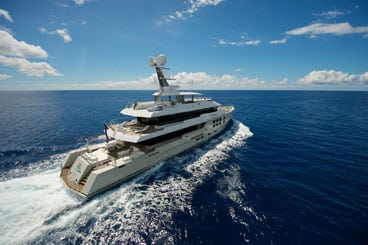
10-08-ybf-7186.jpg
Environmental sensitivity has altered the direction of design in large private vessels. “More designers are going to renewable materials, whether they’re manufactured or re-processed woods,” said John DeCaro of All Ocean Yachts in Fort Lauderdale. Modern production processes let fabricators make more sustainable woods, such as poplar, resemble teak or mahogany. Lay two pieces side by side and even a trained eye has a difficult time telling them apart.
“With synthetic materials, you can do designs, curves and more,” said Luiz de Basto, president of Luiz de Basto Designs in Miami. “Why destroy a tree somewhere in the world?” Bamboo is one sustainable wood that is showing up in decking, paneling and even countertops.
Veneers and lightweight coring are also used by custom builder Hodgdon Yachts of East Boothbay, Maine. In some instances, Hodgdon will hollow out a wood panel for a hatch and core it with aluminum honeycomb or foam, such as Airex, for significant weight savings. By using veneers, Hodgdon can also offer a wider variety of colors. One boat recently built by the company had an interior with a sycamore finish. (Read more on Hodgdon’s cutting edge materials).
Or get rid of wood altogether. A company called Aerospace Structures Limited in New Zealand takes a high-resolution image of wood grain and adheres it to a rail section to make it look just like a piece of rare wood. It can do the same with a piece of glass, giving it the appearance of onyx.
Other green efforts include a move toward more efficient air conditioning and the use of LED lights instead of xenon. In a study of a 111-foot yacht, de Basto found that the switch reduced power draw by 4 kW. Greg Marshall, president of Greg Marshall Design in Vancouver, British Columbia, said that going exclusively with LEDs on Big Fish (pictured above) made a difference of 30 kW of power and saved more than 21,000 gallons of fuel.
On a 60-meter boat under construction, Marshall is interspersing solar panels with glass to help provide some electrical power. Anywhere that privacy might be required, the panels will be used in lieu of clear glass, serving a dual purpose. The boat will also have 33 kW windmill generators to produce power when the boat is at rest. On an upcoming 80-meter vessel, Marshall has introduced a rain room that will catch rainwater and filter it for use on board. The clear tubes of the rain room have in-line generators integrated into them to help produce additional electrical power.
Marshall explained that none of these environmentally friendly alternatives to materials and systems would be possible without customers who are willing to pay for it. He said that when people were talking about “going green” about five years ago, they weren’t serious. The momentum for serious change started within the past three years. “We noticed that people were willing to spend the premium,” Marshall said. “We have people saying ‘If it costs an extra 10 percent to make an environmentally friendly boat, we’ll do it.’”









